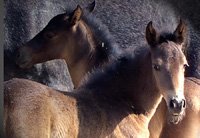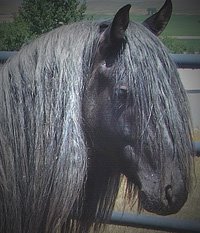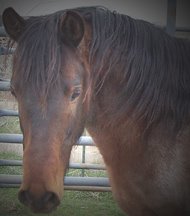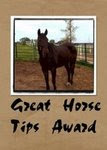 This last factor became a real issue during last Saturday's round of musical horses. We moved Sand- storm, Ripple, and Aaruba into a large paddock together on the theory that Aaruba would be able to defend his grain, and the girls could provide company while all three enjoyed the extra space.
This last factor became a real issue during last Saturday's round of musical horses. We moved Sand- storm, Ripple, and Aaruba into a large paddock together on the theory that Aaruba would be able to defend his grain, and the girls could provide company while all three enjoyed the extra space.Or not.
The instant I turned him loose, Aaruba proceeded to whip the mares, particularly Sandstorm, into a frenzy. Driving her with neck outstretched and teeth bared, he pinned her in corners and sent her full-tilt at fences. I watched for several minutes, wincing at each narrow escape, in the hope they'd work out their differences and high spirits, then settle to eating hay.
Unfortunately, though Sandstorm and Ripple offered to submit, Aaruba showed no sign of resting on his laurels. One particularly harrowing moment involving a downhill scramble toward a wire mesh fence sent me hustling for the gate.
My Barbs and Arabian may be small compared to most horses in the U.S. today, but I am a whole lot smaller. And yet, I was fully confident as I stepped into the fray. At my shout of "Whoa!" Aaruba slammed to a halt. Sides heaving, lips hoary with a bite of Sandstorm's winter coat, he swung around to face me for instructions. With a hand on his jaw, I led him from the paddock.
What magic is this, that a 900-pound hurricane of hooves and muscle bows to my fingertips, even my voice?
I've read the work of so many trainers that I don't recall whose verbiage I borrowed for the title of this post (Parelli, perhaps?), but experiences like Saturday's remind me that there is nothing so important in my horse-human relationships as establishing that I, the trainer, am the better horse.
No human can be physically superior to an equine, of course. Even a week-old foal's kick can knock a strong man flat. However, creating an illusion of physical superiority is a key component of earning a horse's respect. This is particularly true in the case of strong-willed, young, or ungentled horses.
Twitches and stud chains are not the answer, particularly with courageous, hot-blooded breeds. Such devices work only until the trainer's back is turned, if that long, and they'd have done me no good in halting Aaruba's rampage.
Instead, I use the round corral to convince a horse that I can run longer and faster than he. Then, unlike Aaruba, I acknowledge and reward the bowed head, the attentive ear, the lick and chew that signal submission. Over time, I demonstrate to the horse that I am not only unthreatening, but wise. I provide safety in the face of apparent danger, guidance in new situations. I become his leader.
The magic is simply this: To train not the horse's body, but his mind. True, the training is accomplished through the use of physical motion and pressures because these comprise the equine vocabulary, but it is to the mind that we speak.
Among themselves, my horses will establish a hierarchy as nature intended. But I had better be sure -- for my safety and theirs -- that when I stand among the herd, even the most dominant member knows beyond doubt that I am the better horse.
__________________________
Related Posts
Do You Hear What I See?: Communicating with Horses
Outing Stress: Communicating with Horses
A Moment of Silence: Communicating with Horses
Enough is Enough: Communicating with Horses
__________________________
Want to read more posts like this one? We deliver!









No comments:
Post a Comment